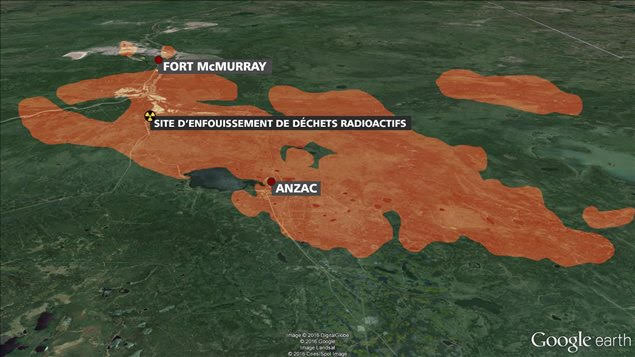With the massive fires raging in and near Fort McMurray in Northern Alberta, concern has been expressed about the integrity of the historic radioactive wastes stored nearby.
The bulky radioactive wastes (43,000 cubic metres = one-and-a-half million cubic feet) stored near Fort McMurray are radium-contaminated materials (contaminated soil and sediment along with contaminated docks and building materials for example) from the Northern Transportation Route. This is the route that Eldorado used to carry radium ore and concentrates from the Port Radium mine (on the eastern arm of the Great Bear Lake) to the refinery in Port Hope, Ontario from 1931 to 1940, and then — after nuclear fission was discovered and the A-Bomb program began — uranium concentrates from 1944 onwards.
The radioactive ore and/or concentrates were carried by Sahtu-Dene native men on their backs in burlap sacks and loaded onto a boat called “The Radium Gilbert” that took about 8 hours to cross the lake to the river near the present-day site of Deline. The ore-carriers would often lie on the sacks as the boat crossed the lake, then they would carry the sacks off the boat and onto a river barge, where the cargo would be carried south to the railhead near the present-day site of Fort MacMurray. From there it would be either flown or sent by rail to Port Hope.
Around the time when Robert Del Tredici and I were invited to Deline to inform the Dene community of the dangers and the ultimate military use of the uranium that was mined at Port Radium, about 1998, a great deal of press and political pressure was generated over what a messy operation it had been. It became clear that the burlap bags sometimes ripped or tore open, showering the ore carriers with radium-bearing material that they were never told could be dangerous. There were no facilities for showering or changing clothes, nor any instructions for the workers to wash thoroughly to remove the radioactive materials from skin and hair.
In the subsequent years, following the adverse publicity, the Low Level Radioactive Waste Management Office (LLRWMO) was formed within the ranks of AECL (Atomic Energy of Canada Limited). Investigation revealed extensive contamination of docks and soil and buildings all along the Northern Transportation Route. Much of the contaminated material — at least the material that was on the surface and easily collected — was packaged and transported to the Fort McMurray area where it has been stored right up to the present time.
====================
MORE ON RADIUM AND URANIUM FROM GREAT BEAR LAKE
How Uranium from Great Bear Lake ended up in A-Bombs
http://ccnr.org/uranium_events.html
1931 Warning re Health Effects of radium-bearing materials
http://ccnr.org/radium_warning.html
Port Radium minesite in the 1930s
http://ccnr.org/port_radium.html
First shipment of radium concentrates from Great Bear Lake (1931)
http://ccnr.org/first_ore.html
Echoes of the Atomic Age, March 14, 1998:
http://ccnr.org/deline_deaths.html
Use of Canadian Uranium in A-Bombs – citations compiled in 1998
http://ccnr.org/uranium_in_bombs.html
Dene people of Great Bear Lake call for federal response to Uranium Deaths
http://ccnr.org/dene.html
===========================
Northern contaminated sites (excerpted from the CNSC web site)
http://nuclearsafety.gc.ca/eng/waste/historic-nuclear-waste/index.cfm
From the early 1930s to the 1950s, uranium ore was transported over 2,200 km by the Northern Transportation Route (NTR) from Port Radium (on Great Bear Lake, Northwest Territories) to the railhead at Waterways (now Fort McMurray, Alberta).
In the 1990s, AECL’s Low-Level Radioactive Waste Management Office (LLRWMO) identified sites impacted by uranium ore along the NTR. The contamination was located primarily in docks and boat launches.
Radiological surveys conducted in 2004, 2005 and 2006 determined the volume of the waste to be approximately 10,000 cubic metres. Following these surveys the LLRWMO removed and consolidated most of the higher-density, uranium-impacted soil from the identified locations.
CNL’s LLRWMO is in charge of continuing to address the historic nuclear waste in Canada’s north.
It is adapting methods of community engagement and technical approaches that have led to successful remediation projects in Canada’s southern regions






